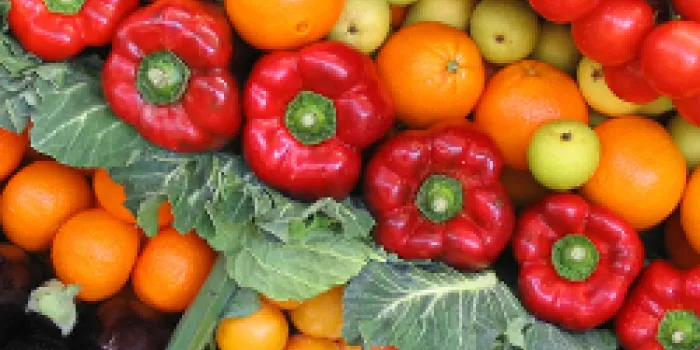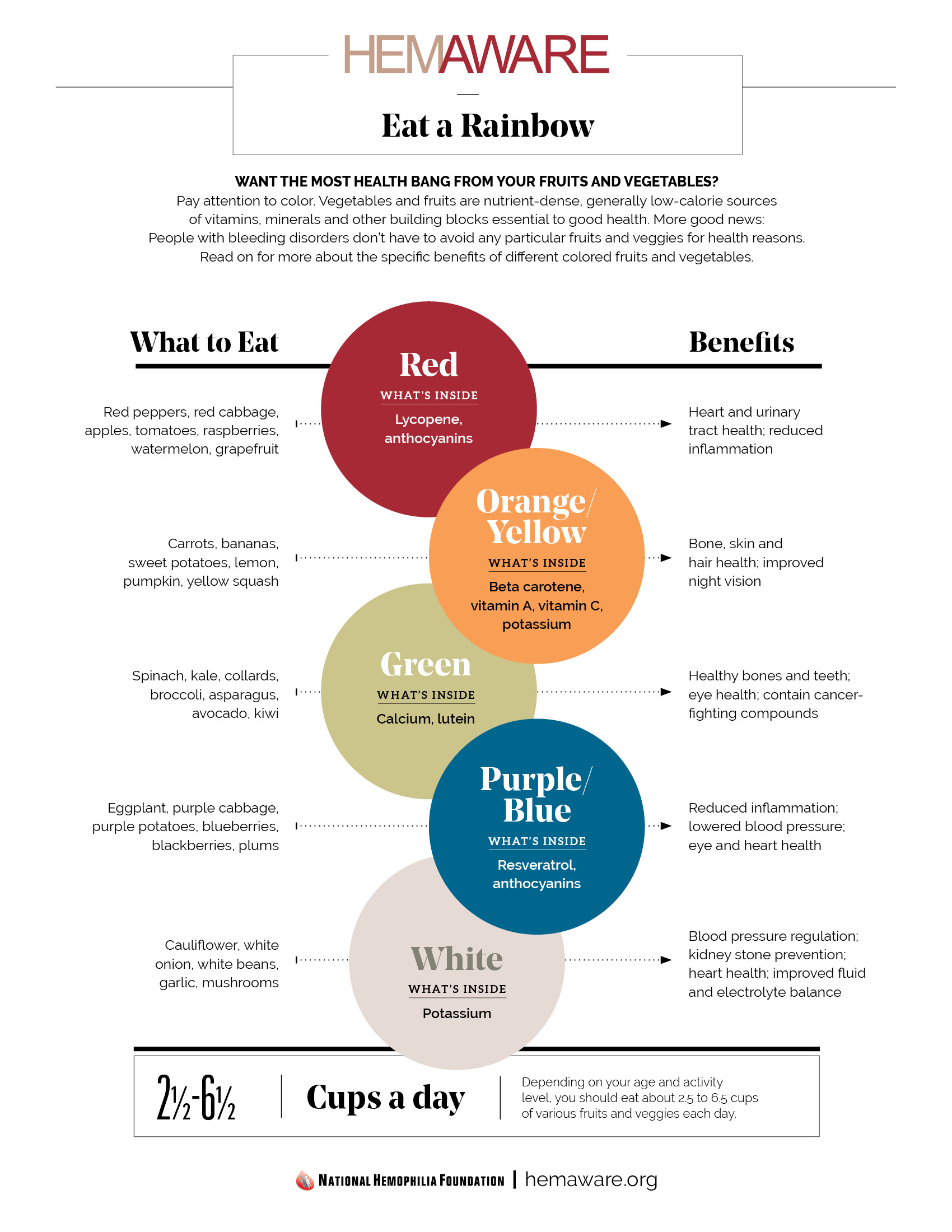When you’re tired and hungry, admit it: you scarf down a bag of potato chips, not a plum. Most of us dive into the chips without thinking, because crunchy, salty snacks are satisfying. But nutritionists tell us what we crave probably isn’t what our bodies need.
Nearly 25 years after the “5 a day” slogan was launched by the National Cancer Institute to get us to eat more produce, we’re still not making the grade. A 2015 study published in the July 10 edition of The Morbidity and Mortality Weekly Report by researchers at the US Centers for Disease Control and Prevention (CDC) showed that 50% of adults eat less than 1 cup of fruit and less than 1.5 cups of vegetables daily. Children scored even worse: 60% eat fewer fruits than recommended; 93% fewer vegetables.
The CDC and Produce for Better Health Foundation, a nonprofit organization, have teamed up to spread the word behind a new slogan: “Fruits & vegetables--more matters.” While 5 a day is a good goal to aim for, more servings are even more beneficial, they say.
Find out more about which foods from the produce section are better for you and what they provide that’s so good for the body.
Necessary nutrition
Most fruits and vegetables are low in fat, cholesterol and calories. “They’re very nutrient dense. Per serving unit, they are full of all kinds of nutrients,” says Tina Willis, MA, RD, registered dietitian at the Indiana Hemophilia & Thrombosis Center in Indianapolis. “Plus, they’re full of fiber.” Fiber, or roughage, makes you feel full and helps prevent constipation. According to the Dietary Guidelines for Americans, 2010, fruits and veggies contain many of the nutrients and vitamins Americans’ diets are lacking: folate, magnesium, potassium and vitamins A, C and K.
Some fruits and veggies even have hidden benefits. For instance, dairy products aren’t the only sources of calcium and vitamin D. Spinach and kale leaves also contain calcium, which builds healthy bones and teeth. Certain portabella mushroom caps contain 100% of your recommended daily allowance of vitamin D. Vitamin D helps the body absorb calcium. The potassium in potatoes, bananas and white beans helps regulate blood pressure, prevent kidney stone formation and protect your heart. It also helps your body maintain fluid and electrolyte balance, and is needed for muscle contractions.
The tomatoes ripening on your windowsill pack a lot of nutritive punch. A medium tomato provides about 1/5 of your daily vitamin A and 25% of your daily vitamin C requirements.
Lycopene, the red pigment in tomatoes, is an antioxidant, protecting cells from damage. It is one of the thousands of phytochemicals or phytonutrients, plant compounds that have healthful benefits.
Nutritionists and dieticians are now touting the benefits of phytochemicals. Among the more than 4,000 of them, some of the most important are flavonoids, which give produce its rich color. Anthocyanins are flavonoids found in blueberries, cranberries, raspberries and strawberries. They are antioxidants. Red, orange and yellow fruits and vegetables get their color from carotenoids, which protect the body against infection and help with wound healing. They’re chock full of vitamin C, which helps the body use iron.
Diets high in beta-carotene have been shown to reduce the risk of heart attacks. Beta-carotene is found in broccoli, carrots, pumpkin and sweet potatoes. Foods with beta-carotene also contain vitamin A, a component of healthy bones, skin and hair, and for night vision. Kale, collards and spinach, all contain lutein, which helps prevent macular degeneration in the eyes. Raw broccoli, apples, berries, kale and onions have cancer-fighting compounds and help prevent heart disease.
Next time you make chili or stew, toss in a combination of kidney, pinto and garbanzo beans. Beans provide protein, fiber, iron and zinc. Along with split peas and black-eyed peas, peanut butter and other nut butters, beans can substitute for animal protein in a vegetarian diet.
Measure for measure
To check off your five a day fruit and vegetables, you need to know how servings are measured. According to the American Heart Association, a small piece of fruit, such as an apple, orange or pear that’s about 2 ½ inches in diameter, counts as one serving. So do ¼ cup of raisins, 8 ounces of cranberry juice and 1 cup of applesauce. For vegetables, the rule of thumb is similar: 1 serving size equals a medium baked potato, ½ of a large sweet potato, 1 cup of cooked greens or 1 cup of raw lettuce.
Fitting them in
Getting the 2 ½ cups of fruit and another 2 ½ cups of vegetables isn’t as hard as it sounds. Divide your plate in half, then fill one side with fresh or cooked produce. Try to eat from the fruit bowl or vegetable bin at each meal. When you eat out, try substituting apple slices for fries. Or request extra lettuce and tomatoes on your sandwich, says Willis. If you’re a picky eater, find tasty ways to meet your daily produce goal creatively. (See sidebar, “Creatively Cooking and Eating.”)
If you’d rather sip than chomp, fruit and vegetable juices do count as servings, but with some cautions. “You’re getting the vitamins and minerals, but you’re not getting the fiber and the satiety (feeling of fullness),” Willis says. Additionally, the calorie counts differ. A medium orange has about 80 calories, whereas 1 cup of orange juice has 110 calories. You can cut the calories and sugar content by watering down juices. Smoothies are a popular way to swallow your fruits and vegetables in liquid form. “There’s nothing wrong with smoothies, but people should know the serving size is half a cup,” Willis says. Plus, you’re sacrificing the fiber when you rev up your juicer.
There are no fruits and vegetables that people with bleeding disorders should avoid, says Willis.
But take supplements with caution. “For instance, people can eat as much garlic as they want but we warn against supplements,” she says. That’s because you could be getting mega-doses, which can increase your bleeding risk.
There is a distinction between natural and added sugars. “The sugar that’s naturally in fruits and vegetables comes in small amounts, with a huge amount of nutrients,” says Willis. Natural sugars include fructose, glucose and sucrose. Added sugar is just for taste, not nutrition, she says. Besides, it adds unnecessary calories. And it can have harmful effects. For instance, high-fructose corn syrup has been linked to liver disease and obesity.
The American Diabetes Association (ADA) encourages eating fruits and vegetables, with some guidance. Fruits and vegetables have carbohydrates, which people with diabetes need to limit. If you have diabetes, avoid starchy vegetables such as corn, potatoes and peas. Instead, the ADA recommends such nonstarchy veggies as beets, beans, broccoli and cauliflower. If you’re counting carbs, all fruits are not created equal. You get 15 grams of carbohydrates from ½ cup of canned fruit, 1/3-1/2 cup of fruit juice and only 2 tablespoons of dried raisins or cherries, says the ADA.
While fresh foods are healthier, frozen come close. “Sometimes frozen is harvested and then processed within a couple of days or a week after they ripen,” Willis says. That’s comparable to what’s displayed in the produce section of your grocery store. Flash-freezing preserves the foods’ healthy nutrients.
Canned foods can substitute for fresh, if you know how to shop. “Because of new processing techniques, canned goods do contain a lot of nutrients,” says Willis. But read labels: buy products with the lowest amounts of sodium, sugar and saturated fats. Before cooking, drain and rinse canned veggies to get rid of excess salt. Look for fruits that are canned in water or natural fruit juice, not heavy syrup, Willis suggests. Or stock up on fruits canned with artificial sweeteners.
That handful of dried apples and bananas you munch during a bike ride is another way to squeeze more fruits into your diet. Dried fruits are nutrient dense, a small amount goes a long way, says Willis. For instance, dried apricots have twice the fiber as the real thing. Along with dried raisins and figs, they are high in beta-carotene, vitamin E, iron, calcium and potassium. And they’re fat-free. Watch out for sugars added in processing, though. And eat them in small quantities. Their high calorie count adds up quickly, Willis says.
And if you insist on organic only, here’s some information. Buying organic produce, which have been grown according to standards set by the US Department of Agriculture (USDA), isn’t necessarily healthier. Studies have not shown nutrition-related health benefits, according to the American Heart Association. However, crops that are certified and bear the label “USDA Organic” do not contain fertilizers, pesticides or genetically modified organisms. Bear in mind that organic fruits and vegetables are typically more expensive.
5 a day is feasible
Five a day is feasible, if you plan ahead. Keep bananas and apples on the kitchen counter, where you’ll see them and reach for them, advises Willis. Or put carrot and celery sticks in a bowl of water in the fridge, for spontaneous snack attacks. Set an alarm on your smartphone to remind you to eat a piece of fruit, instead of raiding the vending machines at work. “If you’re eating the colors of the rainbow, that’s a pretty good indication that you’re getting all the nutrients and phytochemicals you need,” Willis says.
[Download - Eat-the-Rainbow-Healthy-Benefits-of-Fruits-and-Vegetables]


